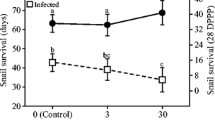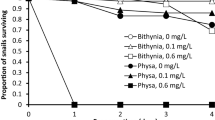Abstract
Neonicotinoids are a popular class of systemic insecticides registered for use in over 120 countries. Recent global water surveys have found neonicotinoid insecticides in waterbodies adjacent to agricultural fields. The presence of neonicotinoids in surface waters raises the concern of the potential risk of exposure to non-target aquatic species, with relevance for both free-living and parasitic taxa. The susceptibility of aquatic free-living parasitic stages to the lethal effects of neonicotinoids may influence the prevalence and intensity of host infection, and their availability as prey for a variety of organisms (e.g., fish, invertebrates). We examined the effects of two commonly used neonicotinoids on the survival of free-living infectious stages (cercariae) from two trematode (flatworm) species (Diplostomum sp. and Haematoloechus sp.). We found that exposure to commercially formulated imidacloprid and thiamethoxam, individually and in a binary mixture, had no significant effect on cercarial survival for either species at environmentally relevant concentrations. Further study is required to understand if the ability of the surviving cercariae to infect the next host in their life cycle is compromised in the presence of neonicotinoids, or if host defenses are compromised, as changes in parasite infectivity or host susceptibility could influence infection dynamics and have community- and ecosystem-level implications.


Similar content being viewed by others
References
Anderson, J. C., Dubetz, C., & Palace, V. P. (2015). Neonicotinoids in the Canadian aquatic environment: A literature review on current use products with a focus on fate, exposure, and biological effects. Science of the Total Environment, 505, 409–422.
Blaustein, A. R., Han, B. A., Relyea, R. A., Johnson, P., Buck, J. C., Gervasi, S. S., & Kats, L. B. (2011). The complexity of amphibian population declines: Understanding the role of cofactors in driving amphibian losses. Annals of the New York Academy of Sciences, 1223, 108–119.
Bolek, M. G., & Janovy Jr., J. (2007). Evolutionary avenues for, and constraints on the transmission of frog lung flukes (Haemotoloechus spp.) in dragonfly second intermediate hosts. The Journal of Parasitology, 93, 593–607.
Bonmatin, J. M., Giorio, C., Girolami, V., Goulson, D., Kreutzweiser, D. P., Krupke, C., et al. (2015). Environmental fate and exposure; neonicotinoids and fipronil. Environmental Science and Pollution Research, 22, 35–67.
Bridges, C. M., & Semlitsch, R. D. (2000). Variation in pesticide tolerance of tadpoles among and within species of Ranidae and patterns of amphibian decline. Conservation Biology, 14, 1490–1499.
Buckingham, S. D., Lapied, B., Corronc, H. L. E., Grolleau, F., & Satelle, D. B. (1997). Imidacloprid actions on insect neuronal acetylcholine receptors. Journal of Environmental Biology, 200, 2685–2692.
CCME. (2007). Canadian Water Quality Guidelines: Imidacloprid. Scientific supporting document. Winnipeg: Canadian Council of Ministers of the Environment.
Chappell, L. H. (1995). The biology of diplostomatid eyeflukes of fishes. Journal of Helminthology, 69, 97–101.
Clarke, A. H. (1981). The freshwater molluscs of Canada. Ottawa: National Museums of Canada.
Coors, A., & Meester, L. D. (2008). Synergistic, antagonistic and additive effects of multiple stressors: Predation threat, parasitism and pesticide exposure in Daphnia magna. Journal of Applied Ecology, 45, 1820–1828.
Coors, A., Decaestecker, E., Jansen, M., & Meester, L. D. (2008). Pesticide exposure strongly enhances parasite virulence in an invertebrate host model. Oikos, 117, 1840–1846.
Cothran, R. D., Brown, J. M., & Relyea, R. A. (2013). Proximity to agriculture is correlated with pesticide tolerance: Evidence for the evolution of amphibian resistance to modern pesticides. Evolutionary Applications, 6, 832–841.
Crawley, M. J. (2007). The R book. Chischerter: John Wiley & Sons Ltd..
Deneer, J. W. (2000). Toxicity of mixtures of pesticides in aquatic systems. Pest Management Science, 56, 516–520.
Dobson, A., Lafferty, K. D., Kuris, A. M., Hechinger, R. F., & Jetz, W. (2008). Homage to Linnaeus: How many parasites? How many hosts? Proceedings of the National Academy of Sciences, 105, 11482–11489.
Erasmus, D. A. (1972). The biology of trematodes. London: Edward Arnold (Publishers) Ltd.
Fried, B., Pane, P. L., & Reddy, A. (1997). Experimental infection of Rana pipiens tadpoles with Echinostoma trivolvis cercariae. Parasitology Research, 83, 666–669.
Hua, J., Buss, N., Kim, J., Orlofske, S. A., & Hoverman, J. T. (2016). Population-specific toxicity of six insecticides to the trematode Echinoparyphium sp. Parasitology, 143, 542–550.
IBM Corp. (2016). IBM SPSS Statistics for Windows, Version 24.0. Armonk: IBM Corp.
Jeschke, P., Nauren, R., Schindler, M., & Elbert, A. (2011). Overview of the status and global strategy for neonicotinoids. Journal of Agricultural and Food Chemistry, 59, 2897–2908.
Karvonen, A., Paukku, S., Valtonen, E. T., & Hudson, P. J. (2003). Transmission, infectivity, and survival of Diplostomum spathaceum cercariae. Parasitology, 127, 217–224. https://doi.org/10.1017/S0031182003003561.
King, K. C., McLaughlin, J. D., Gendron, A. D., Pauli, B. D., Giroux, I., Rondeau, B., et al. (2007). Impacts of agriculture on the parasite communities of northern leopard frogs (Rana pipiens) in southern Quebec, Canada. Parasitology, 134(14), 2063–2080.
King, K. C., Mclaughlin, J. D., Boily, M., & Marcogliese, D. J. (2010). Effects of agricultural landscape and pesticides on parasitism in native bullfrogs. Biological Conservation, 143, 302–310.
Koprivnikar, J., & Redfern, J. C. (2012). Agricultural effects on amphibian parasitism: Importance of general habitat perturbations and parasite life cycles. Journal of Wildlife Diseases, 48(4), 925–936.
Koprivnikar, J., Forbes, M. R., & Baker, R. L. (2006). Effects of atrazine on cercarial longevity, activity, and infectivity. The Journal of Parasitology, 92, 306–311.
Koprivnikar, J., Forbes, M. R., & Baker, R. L. (2007). Contaminant effects on host-parasite interactions: Atrazine, frogs, and trematodes. Environmental Toxicology and Chemistry, 26, 2166–2170.
Koprivnikar, J., Marcogliese, D. J., Rohr, J. R., Orlofske, S. A., Raffel, T. R., & Johnson, P. T. (2012). Macroparasite infections of amphibians: What can they tell us? EcoHealth, 9, 342–360.
Lafferty, K. D., Allesina, S., Arim, M., Briggs, C. J., De Leo, G., Dobson, A. P., et al. (2008). Parasites in food webs: The ultimate missing links. Ecology Letters, 11, 533–546.
Loos, R., Gawlik, B. M., Locoro, G., Rimaviviute, E., Contini, S., & Bidoglio, G. (2009). EU-wide survey of polar organic persistent pollutants in European River waters. Environmental Pollution, 157(2), 561–568.
Maloney, E. M., Morrissey, C. A., Headley, J. V., Peru, K. M., & Liber, K. (2017). Cumulative toxicity of neonicotinoid insecticide mixtures to Chironomus dilutus under acute exposure scenarios. Environmental Toxicology and Chemistry, 36, 3091–3101.
Maloney, E. M., Morrissey, C. A., Headley, J. V., Peru, K. M., & Liber, K. (2018). Can chronic exposure to imidacloprid, clothianidin, and thiamethoxam mixtures exert greater than additive toxicity in Chironomus dilutus? Ecotoxicology and Environmental Safety, 156, 354–365.
Mesnage, R., Defarge, N., Spiroux de Vendômois, J., & Séralini, G.-E. (2014). Major pesticides are more toxic to human cells than their declared active principles. BioMed Research International. https://doi.org/10.1155/2014/179691.
Morley, N. J. (2012). Cercariae (Platyhelminthes: Trematoda) as neglected components of zooplankton communities in freshwater habitats. Hydrobiologia, 69, 7–19.
Morley, N. J., Crane, M., & Lewis, J. W. (2001). Toxicity of cadmium and zinc to Diplostomum spathaceum (Trematoda: Diplostomidae) cercarial survival. International Journal for Parasitology, 31, 1211–1217.
Morrissey, C. A., Mineau, P., Devries, J. H., Sanchez-Bayo, F., Liess, M., Cavallaro, M. C., & Liber, K. (2015). Neonicotinoid contamination of global surface waters and associated risk to aquatic invertebrates: A review. Environment International, 74, 291–303.
Olivier, L. J. (1966). Infectivity of Schistosoma mansoni cercariae. The American Journal of Tropical Medicine and Hygiene, 15, 882–885.
Olsen, O.W. (1986). Animal parasites: Their life cycles and ecology. New York, NY: Dover Publications.
Orlofske, S. A., Jadin, R., & Johnson, P. T. (2015). It’s a predator–eat–parasite world: How characteristics of predator, parasite and environment affect consumption. Oecologia, 178, 537–547.
Pavlaki, M. D., Pereira, R., Loureiro, S., & Soares, A. M. V. M. (2011). Ecotoxicology and environmental safety effects of binary mixtures on the life traits of Daphnia magna. Ecotoxicology and Environmental Safety, 74, 99–110.
Pietrock, M., & Goater, C. P. (2005). Infectivity of Ornithodiplostomom pytchocheilus and Posthodiplostomum minimum (Trematoda: Diplostomidae) cercariae following exposure to cadmium. The Journal of Parasitology, 91, 854–856.
Preston, D. L., Orlofske, S. A., Lambden, J. P., & Johnson, P. T. (2013). Biomass and productivity of trematode parasites in pond ecosystems. The Journal of Animal Ecology, 82, 509–517.
Prosser, R. S., de Solla, S. R., Holman, E. A. M., Osborne, R., Robinson, S. A., Bartlett, A. J., et al. (2016). Sensitivity of the early-life stages of freshwater mollusks to neonicotinoid and butenolide insecticides. Environmental Pollution, 218, 428–435.
Robinson, S. A., Richardson, S. D., Dalton, R. L., Maisonneuve, F., Trudeau, V. L., Pauli, B. D., & Lee-Jenkins, S. S. Y. (2017). Sublethal effects on wood frogs chronically exposed to environmentally relevant concentrations of two neonicotinoid insecticides. Environmental Toxicology and Chemistry, 36, 1101–1109.
Robinson, S. A., Gavel, M. J., Richardson, S. D., Chlebak, R. J., Milotic, D., Koprivnikar, J., & Forbes, M. (2019). Sub-chronic exposure to a neonicotinoid does not affect susceptibility of larval leopard frogs to infection by trematode parasites, via either depressed cercarial performance or host immunity. Parasitology Research. https://doi.org/10.1007/s00436-019-06385-9.
Rosenkranz, M., Lagrue, C., Poulin, R., & Selbach, C. (2018). Small snails, high productivity? Larval output of parasites from an abundant host. Freshwater Biology, 63, 1602–1609.
Santos, M. J., Karvonen, A., Pedro, J. C., Faltýková, A., Seppälä, O., & Valtonen, E. T. (2007). Qualitative and quantitative behavioural traits in a community of furcocercariae trematodes: Tools for species separation? The Journal of Parasitology, 93(6), 1319–1323.
Schell, S. C. (1970). How to know trematodes. Iowa: W.C. Brown Company Publishers.
Schell, S. C. (1985). Handbook of trematodes of North America north of Mexico. Idaho: University Press of Idaho.
Schotthoefer, A. M., Labak, K. M., & Beasley, V. R. (2007). Ribeiroia ondatrae cercariae are consumed by aquatic invertebrate predators. The Journal of Parasitology, 93, 1240–1243.
Shariff, M., Richards, R. H., & Sommerville, C. (1980). The histopathology of acute and chronic infections of rainbow trout Salmo gairdneri with eye flukes, Diplostomum spp. Journal of Fish Diseases, 3, 455–465.
Simon-Delso, N., Amaral-Rogers, V., Belzunces, L. P., et al. (2015). Systemic insecticides (neonicotinoids and fipronil): Trends, uses, mode of action and metabolites. Environmental Science and Pollution Research, 22, 5–34.
Stuart, S. N., Chanson, J. S., Cox, N. A., Young, B. E., Rodrigues, A. S. L., Fischman, D. L., & Waller, R. W. (2004). Status and trends of amphibian declines and extinctions worldwide. Science, 306, 1783–1786.
Szuroczki, D., & Richardson, J. M. L. (2009). The role of trematode parasites in larval anuran communities: An aquatic ecologist’s guide to the major players. Oecologia, 161, 371–385.
Takács, E., Klátyik, S., Môrtl, M., Rácz, G., Kovács, K., et al. (2017). Effects of neonicotinoid insecticide formulations and their components on Daphnia magna–The role of active ingredients and co-formulants. International Journal of Environmental Anlytical Chemistry, 97(9), 885–900.
Toledo, R., Munoz-Antoli, C., Pérez, M., & Esteban, J. G. (1999). Survival and infectivity of Hypoderaeum conoideum and Euparyphium albuferensis cercariae under laboratory conditions. Journal of Helminthology, 73, 177–182.
Tomizawa, M., & Casida, J. E. (2003). Selective toxicity of neonicotinoids attributable to specificity of insect and mammalian nicotinic receptors. Annual Review of Entomology, 48, 339–364.
Tomizawa, M., & Yamamoto, I. (1992). Binding of nicotinoids and the related compounds to the insect nicotinic acetylcholine receptor. Journal of Pesticide Science, 17, 231–236.
Acknowledgments
We thank France Maisonneuve and Eric Pelletier from Environment and Climate Change Canada’s Laboratory Services at the National Wildlife Research Centre for the neonicotinoid chemical analyses.
Funding
Funding was provided by the Environment and Climate Change Canada.
Author information
Authors and Affiliations
Corresponding author
Ethics declarations
Conflict of Interest
The authors declare that they have no conflict of interest.
Additional information
Publisher’s Note
Springer Nature remains neutral with regard to jurisdictional claims in published maps and institutional affiliations.
Electronic Supplementary Material
ESM 1
(XLSX 55 kb)
Rights and permissions
About this article
Cite this article
Rohonczy, J.L.M., Koprivnikar, J., Waltho, N. et al. The Effects of the Commercially Formulated Neonicotinoids Imidacloprid and Thiamethoxam on the Survival of Infectious Stages of Two Trematode Parasites. Water Air Soil Pollut 231, 125 (2020). https://doi.org/10.1007/s11270-020-04510-4
Received:
Accepted:
Published:
DOI: https://doi.org/10.1007/s11270-020-04510-4




